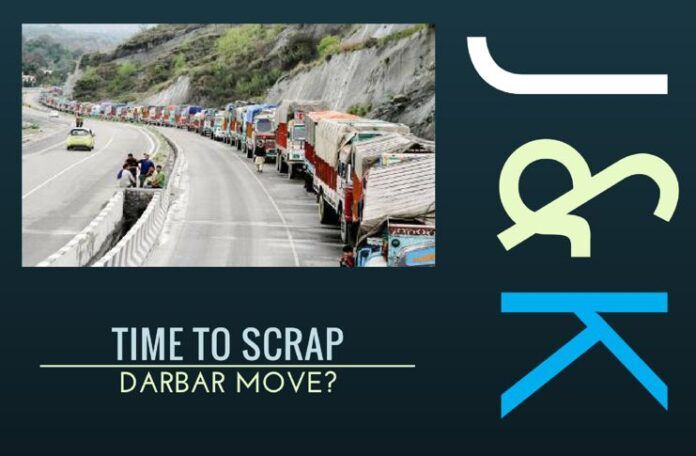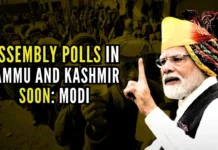
[dropcap color=”#008040″ boxed=”yes” boxed_radius=”8px” class=”” id=””]T[/dropcap]he State of Jammu and Kashmir (J&K) came into being in March 1846 under the Treaty of Amritsar, signed between the British Indian Government and Raja of Jammu, Gulab Singh. It was Kashmir which was added to the Dogra kingdom whose capital was Jammu city, and not the vice-versa. Gulab Singh paid Rs 75 lakh in lieu of Kashmir he got. The British would not have entered into treaty with Gulab Singh, had the Lahore Darbar fallen before March 1846. Punjab fell in 1849.
Convinced that Gulab Singh would not allow the British Indian Government to construct military roads or secure the northern frontier against the Russians, the Britons started instigating the Kashmiri Muslims against the Dogra rule.
Soon after the emergence of J&K, the British started interfering in the internal affairs of the State. Its objective was to coerce the Dogra ruler to allow them to construct military roads in the strategic northern areas of J&K (read Gilgit-Baltistan) and to avert the possibility of Russia entering into Afghanistan to create troubles for London in the region. Gulab Singh opposed the British moves.
Convinced that Gulab Singh would not allow the British Indian Government to construct military roads or secure the northern frontier against the Russians, the Britons started instigating the Kashmiri Muslims against the Dogra rule. In fact, a year after Kashmir got merged with Dogra kingdom, the Kashmiri Muslim religious leadership approached the British Indian Government and sought revocation of the Treaty of Amritsar. They submitted a memorandum to the British Indian Government in 1847. Their argument against the Treaty was that the “British sold the life, dignity and honour of Kashmiri Muslims to the Dogras of Jammu for Rs 75 lakh”.
The Kashmiri Muslim leadership all through opposed the Treaty of Amritsar. The last resolution against the Treaty was adopted in 1946 by the Kashmir-based and Sheikh Abdullah-founded National Conference. The resolution said: “The Treaty of Amritsar be thrown out lock, stock and barrel”. Such was the attitude of the Kashmiri Muslim leadership towards the Treaty of Amritsar.
[dropcap color=”#008040″ boxed=”yes” boxed_radius=”8px” class=”” id=””]I[/dropcap]t was this opposition in Kashmir which made the task of the canny, imperialist and expansionist Britons easy. They started exploiting the Kashmiri Muslim opposition to their advantage. They also appointed Officer on Special Duty in J&K immediately after signing the Treaty with Gulab Singh to promote the British interests in J&K at whatever cost.
…the British exploited the Kashmiri Muslims to the hilt and sought to create problem after problem for the Dogra Kingdom in the Kashmir Valley.
Things reached a climax during the time of Maharaja Ranbir Singh (1851-1885). The British tried to persuade him to agree to their demands and allow them a freehand in J&K. Like Gulab Singh, Ranbir Singh also didn’t oblige. And the result was that the British exploited the Kashmiri Muslims to the hilt and sought to create problem after problem for the Dogra Kingdom in the Kashmir Valley.
The situation in the 1860s and at the beginning of the eighth decade of the 19th century was such that Maharaja Ranbir Singh started the practice of moving his darbar from Jammu to Srinagar during the summer months for 6 months and back. His objective was to watch with vigilance and defeat the conspiratorial activities indulged in by the British officials and anti-Dogra Kashmiri Muslim religious leadership. Yet another objective of his was to create an environment that would strengthen emotional bond between Kashmiri Muslims and the people of Jammu province – a dream that remained a dream. The only difference was that while the Kashmiri Muslim leadership fought against the Treaty of Amritsar between 1847 and 1946, it discarded this century-old demand in 1947 and started demanding independence from India for the whole of State of J&K.
The practice of darbar move from Jammu, the permanent capital of J&K, and Srinagar worked well. It helped the Dogra rulers to understand Kashmiri and Kashmiri psyche and undertake measures to bring Kashmir closer to Jammu then ever before. And, this, notwithstanding the fact that Sheikh Abdullah and his coterie of radical Islamists created trouble after trouble for the Dogra rule in Kashmir, with Jawaharlal Nehru and his Congress always at their beck and call.
[dropcap color=”#008040″ boxed=”yes” boxed_radius=”8px” class=”” id=””]T[/dropcap]he situation changed in August 1947. That year, the weak London decided to quit India and transfer power to the Congress it had founded in December 1885 at Bombay to defeat the then ongoing freedom movement in India. That year, the British Paramountcy also lapsed and the rulers of the 560-odd princely states became virtually independent. However, the Indian Independence Act of 1947 made it loud and clear that the princely states had to accede to either the newly-created Indian Dominion or the Pakistan Dominion taking into account the contiguity factor. It nowhere said that the princes had to decide the future of their respective states on the basis of demography.
Nehru forced the then ruler of J&K, Maharaja Hari Singh, to abdicate his authority in favour of Sheikh Abdullah and he did it in the interest of the under-attack people of J&K.
All, barring half a dozen princely states, acceded to the Indian Dominion or the Pakistan Dominion. Bulk of them acceded to the Indian Dominion for obvious reasons. J&K acceded to the Indian Dominion on October 26-27, 1947 in terms of the constitutional law on the subject. Nehru forced the then ruler of J&K, Maharaja Hari Singh, to abdicate his authority in favour of Sheikh Abdullah and he did it in the interest of the under-attack people of J&K. In fact, Nehru accepted the offer of J&K accession to India on the condition that Hari Singh will hand over the state power to Sheikh Abdullah.
It needs to be underlined that the Dogra Maharajas were the only link between Jammu and Kashmir. As for the people of the two regions, they never came closer to each other. They were antagonistic towards each other. The people of Jammu hated the Kashmiri Muslims because they hated the Dogra rule. Similarly, the Kashmiri Muslim leadership had poisoned the minds of the Kashmiri Muslims and taught them to believe that the Dogras were aliens, oppressors and aggressors and they had perpetrated senseless brutalities on them, which was not true. The Dogra Maharajas were very generous towards Kashmir and they took all steps to develop Kashmir. Anyway, this not the point under scrutiny; the point under scrutiny is the practice of darbar move.
As said, the Dogra rulers were the only link between the two regions. And, once J&K acceded to India and the Dogra rule ceased to exist, that link disappeared. What was then required was to abandon the practice of darbar move but it was not done. What was done was to the contrary. The practice was allowed to be continued.
[dropcap color=”#008040″ boxed=”yes” boxed_radius=”8px” class=”” id=””]T[/dropcap]he archaic practice of darbar move has not only been causing enormous financial loss to the state exchequer every year, but has caused difficulties for the people of the state, especially the people of Jammu and Ladakh, who always considered Kashmir, Kashmiri ruling class and Kashmiri bureaucracy hostile towards them. The people of Kashmir and Ladakh have to come to Jammu during winter months to get their official work done and the people of Jammu and Ladakh have to go to Srinagar for the same purpose during summer months and in the process incur huge financial losses.
What, then, is the way out? Obviously, reorganization of the state on a regional, as opposed to religious, basis.
The J&K Government annually spends more than Rs 15 crore for moving the offices, records and employees from Jammu to Srinagar and back every six months. More than 40 offices and their sub-departments move in after functioning for six months in Jammu and Srinagar while 45 departments move in camp. The latter carry 33 per cent of their staff strength. All the move offices, besides the manpower and other office paraphernalia, shift truck-loads of official records every six months. A special security cover is provided to the move employees and the records all along the route up to their destination. Handsome travel allowance is paid to each employee, irrespective of his or her designation. For around 10,000 move employees, including secretariat employees, police, judiciary and corporations, the TA alone runs into crores. More than 3500 employees also avail facility of government accommodation both in Jammu and Srinagar.
The practice of darbar move has outlived its utility and it has in no way mitigated the hardships and problems of the general populace. In fact, things have worsened in the state to the extent that neither people of Jammu and Ladakh wish to do any political business with Kashmiri Muslims nor the Kashmiri Muslims have any love lost for the people of Jammu and Ladakh. All are pulling in different directions and the Kashmiri leaders have instead of bridging the gap between them have only widened it further through their anti-India and anti-Jammu statements and through their activities, which are subversive in nature and implications.
The practice of darbar move has to be abandoned in the larger interest of the people but the Kashmiri leadership will not allow this to happen as it helps Kashmir exploit and loot and plunder the people of Jammu province and their invaluable natural resources.
What, then, is the way out? Obviously, reorganization of the state on a regional, as opposed to religious, basis. This will (1) help the people of all the three regions, as they would then not be required to visit Jammu or Srinagar to get their official work done, (2) harmonise relations between the people of Jammu, Kashmir and Ladakh, as none would have any complaint against any region, (3) restrict the area of strife to the small Valley, and (4) enable New Delhi to deal with Kashmir in a most effective manner.
Even otherwise, there is no other alternative left given the fact that Kashmiri leaders of all hues want a dispensation outside the constitutional organization of India, something the people of Jammu and Ladakh hate and despise.
- ‘Kashmir My core constituency’: Revisiting July 12, 2003 to understand politics, Omar Abdullah-style - March 15, 2024
- Total deviation from traditional approach: Seven takeaways from PM Modi’s March 7 Srinagar visit - March 9, 2024
- Status of political parties: Why is further J&K reorganization imperative? - March 1, 2024










